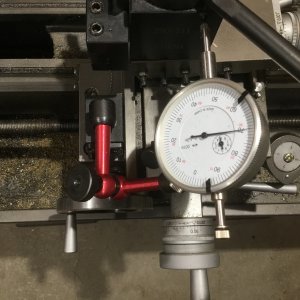Hi All
So I'm trying to make some guitar saddles that have a #6 x 40 threaded side to it. The saddles are from 3/8" round bar so I am taking the stock down quite a bit.
The goal is to get to the #6 max diameter of .138". My dial on my cross slide says it's in .002" increments. However, the dial indicator I hooked up shows it as incrementing .001" per graduation. I'll turn the cross slide five increments for a .005" cut and the dial indicator confirms I added .005". So great, I know what the increments are now so I can move on. Well, I was at .190" and I took .005" cuts down to .160" and stopped to measure. The micrometer read .130".
What the heck is going on?
I watched the dial on the cross slide and the dial indicator as I made each cut and they both matched .005" all the way down before I stopped.
Now I have to face that piece off aagain and start over.
Any and all help is greatly appreciated.
The lathe I'm using is a Jet BDB-919.
So I'm trying to make some guitar saddles that have a #6 x 40 threaded side to it. The saddles are from 3/8" round bar so I am taking the stock down quite a bit.
The goal is to get to the #6 max diameter of .138". My dial on my cross slide says it's in .002" increments. However, the dial indicator I hooked up shows it as incrementing .001" per graduation. I'll turn the cross slide five increments for a .005" cut and the dial indicator confirms I added .005". So great, I know what the increments are now so I can move on. Well, I was at .190" and I took .005" cuts down to .160" and stopped to measure. The micrometer read .130".
What the heck is going on?
I watched the dial on the cross slide and the dial indicator as I made each cut and they both matched .005" all the way down before I stopped.
Now I have to face that piece off aagain and start over.
Any and all help is greatly appreciated.
The lathe I'm using is a Jet BDB-919.


